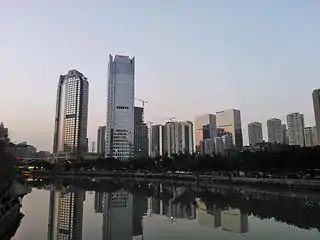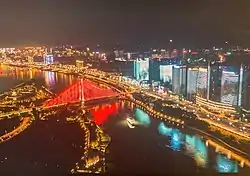Mianyang
Mianyang (simplified Chinese: 绵阳; traditional Chinese: 綿陽; pinyin: Miányáng; Wade–Giles: Mien2-yang2; formerly known as Mienchow) is the second largest prefecture-level city of Sichuan province in Southwest China. Located in north-central Sichuan covering an area of 20,281 square kilometres (7,831 sq mi) consisting of Jiangyou, a county-level city, five counties, and three urban districts. Its total population was 4,868,243 people at the 2020 Chinese census, of whom 2,232,865 live in its built-up (or metro) area made of three urban districts.
Mianyang
绵阳市 | |
|---|---|
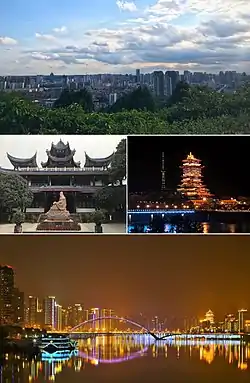 Clockwise from top: The view of Mianyang City from Fule Park, Yuewang Mansion at night, Night scene along Fujiang River in Mianyang City, Ziyun Pavilion in Xishan Park of Mianyang | |
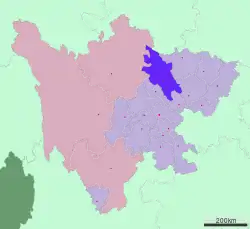 Location of Mianyang in Sichuan | |
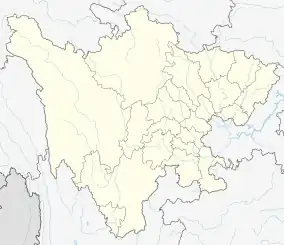 Mianyang Location of the city center in Sichuan 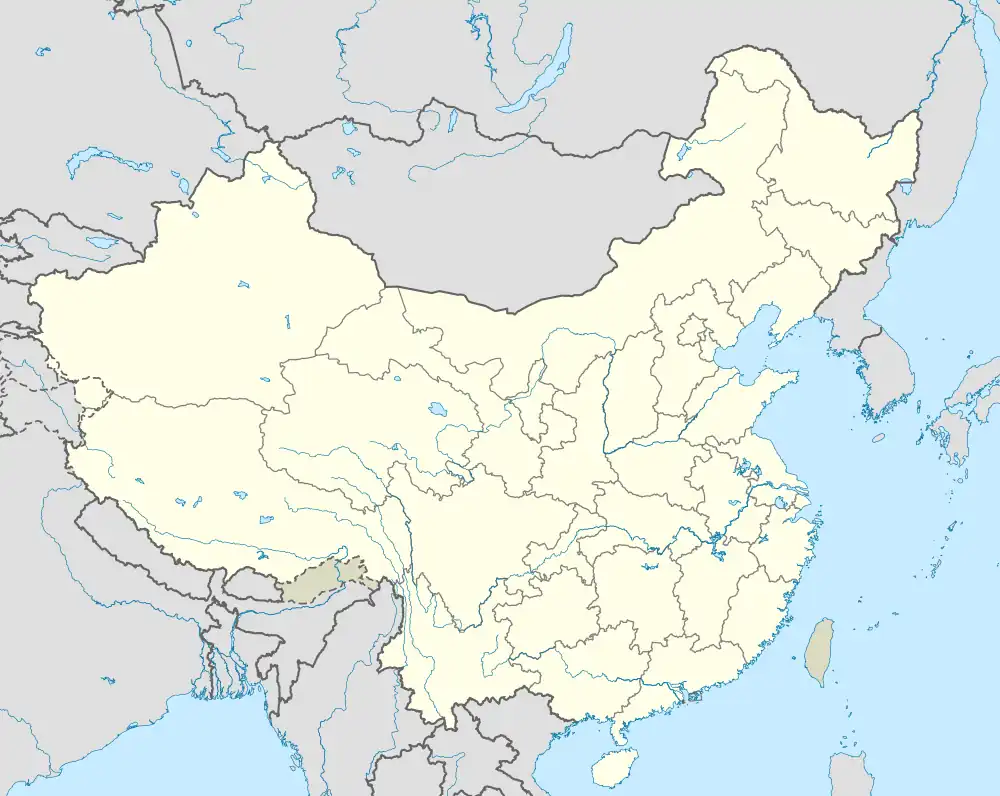 Mianyang Mianyang (China) | |
| Coordinates (Mianyang municipal government): 31°28′05″N 104°40′44″E | |
| Country | People's Republic of China |
| Province | Sichuan |
| Municipal seat | Fucheng District |
| Government | |
| • CPC Party Chief | Peng Yuxing |
| • Mayor | Liu Chao |
| Area | |
| • Prefecture-level city | 20,267.46 km2 (7,825.31 sq mi) |
| • Urban | 2,755.4 km2 (1,063.9 sq mi) |
| • Metro | 2,755.4 km2 (1,063.9 sq mi) |
| Elevation | 473 m (1,552 ft) |
| Highest elevation | 5,588 m (18,333 ft) |
| Lowest elevation | 307 m (1,007 ft) |
| Population (2020 census)[1] | |
| • Prefecture-level city | 4,868,243 |
| • Density | 240/km2 (620/sq mi) |
| • Urban | 2,232,865 |
| • Urban density | 810/km2 (2,100/sq mi) |
| • Metro | 2,232,865 |
| • Metro density | 810/km2 (2,100/sq mi) |
| Time zone | UTC+8 (China Standard) |
| Postal code | 621000 |
| Area code | 0816 |
| ISO 3166 code | CN-SC-07 |
| License Plate Prefix | 川B |
| Tree | Cinnamomum camphora |
| Flower | Rosa chinensis |
| Website | www |
| Miányáng | |||||||||||||||
|---|---|---|---|---|---|---|---|---|---|---|---|---|---|---|---|
"Miányáng" in Chinese characters | |||||||||||||||
| Simplified Chinese | 绵阳 | ||||||||||||||
| Traditional Chinese | 綿陽 | ||||||||||||||
| Literal meaning | "South of Mian Mountain" | ||||||||||||||
| |||||||||||||||
History
Mianyang, which was known as Fuxian (Fu County) in ancient times, had advanced in agriculture during the Qin (221−206 BCE) and Han (206 BCE−220 CE) dynasties. It has a history of over 2,200 years since the Emperor Gaozu of Han established the first county in this area in 201 BCE. Due to its advantageous location, it had always been a town of great military importance and formed a natural defence for Chengdu.[2]
Mianyang is home to the CAEP and Science City, an immense Military Research Complex which was the site of the development of China's first nuclear bomb.
The city proper itself was only lightly damaged by the earthquake of 12 May 2008. However, Beichuan County, which is in the prefecture, was among the most severely hit of all disaster regions following the earthquake, including the Beichuan High School campus where more than 1,000 students lost their lives after two main buildings collapsed.[3] Around 80% of the county's buildings are said to have collapsed, including its main government building.[4] The casualty toll for the quake in Mianyang Prefecture as of 7 June 2008, was 21,963 people killed, 167,742 injured, and 8,744 people missing.[5][6]
Geography and climate
Mianyang is at the northwestern end of the Sichuan Basin, on the upper to middle reaches of the Fu River. Its administrative area ranges in latitude from 30° 42' to 33° 03' N and in longitude from 103° 45' to 105° 43' E. Bordering prefectures are Guangyuan to the northeast, Nanchong to the east, Suining to the south, Deyang to the southwest, and the Ngawa Tibetan and Qiang Autonomous Prefecture to the west. It also borders Gansu for a small section in the north.
Mianyang has a monsoon-influenced humid subtropical climate (Köppen Cwa) and is largely mild and humid, with four distinct seasons. Winter is short, mild, and foggy, though precipitation is low. January averages 5.3 °C (41.5 °F), and while frost may occur, snow is rare. Summers are long, hot, and humid, with highs often exceeding 30 °C (86 °F). The daily average in July, the warmest month, is 25.7 °C (78.3 °F). Rainfall is light in winter and can be heavy in summer, and more than 70% of the annual total occurs from May to September. The annual frost-free period across most of the prefecture lasts from 252 to 300 days, and there are only 1,100 hours of sunshine annually, which is not even 30% of the possible total.
| Climate data for Mianyang (1991–2020 normals, extremes 1971–2000) | |||||||||||||
|---|---|---|---|---|---|---|---|---|---|---|---|---|---|
| Month | Jan | Feb | Mar | Apr | May | Jun | Jul | Aug | Sep | Oct | Nov | Dec | Year |
| Record high °C (°F) | 19.0 (66.2) |
23.9 (75.0) |
32.1 (89.8) |
33.9 (93.0) |
35.9 (96.6) |
36.8 (98.2) |
38.9 (102.0) |
41.0 (105.8) |
36.6 (97.9) |
31.7 (89.1) |
25.0 (77.0) |
20.8 (69.4) |
41.0 (105.8) |
| Average high °C (°F) | 9.6 (49.3) |
12.5 (54.5) |
17.4 (63.3) |
23.3 (73.9) |
27.1 (80.8) |
29.3 (84.7) |
30.9 (87.6) |
30.7 (87.3) |
26.1 (79.0) |
21.1 (70.0) |
16.2 (61.2) |
10.8 (51.4) |
21.2 (70.3) |
| Daily mean °C (°F) | 6.0 (42.8) |
8.6 (47.5) |
12.9 (55.2) |
18.2 (64.8) |
22.1 (71.8) |
24.7 (76.5) |
26.5 (79.7) |
26.1 (79.0) |
22.1 (71.8) |
17.5 (63.5) |
12.6 (54.7) |
7.4 (45.3) |
17.1 (62.7) |
| Average low °C (°F) | 3.3 (37.9) |
5.7 (42.3) |
9.6 (49.3) |
14.3 (57.7) |
18.2 (64.8) |
21.3 (70.3) |
23.2 (73.8) |
22.8 (73.0) |
19.5 (67.1) |
15.1 (59.2) |
10.1 (50.2) |
4.8 (40.6) |
14.0 (57.2) |
| Record low °C (°F) | −5.3 (22.5) |
−4.3 (24.3) |
−3.4 (25.9) |
0.3 (32.5) |
7.2 (45.0) |
14.2 (57.6) |
17.3 (63.1) |
15.8 (60.4) |
13.3 (55.9) |
3.8 (38.8) |
−2.1 (28.2) |
−7.3 (18.9) |
−7.3 (18.9) |
| Average precipitation mm (inches) | 8.4 (0.33) |
9.4 (0.37) |
20.2 (0.80) |
45.6 (1.80) |
77.0 (3.03) |
98.5 (3.88) |
213.8 (8.42) |
175.2 (6.90) |
130.7 (5.15) |
40.5 (1.59) |
12.9 (0.51) |
5.5 (0.22) |
837.7 (33) |
| Average precipitation days (≥ 0.1 mm) | 5.7 | 6.1 | 8.8 | 10.9 | 12.6 | 13.5 | 14.3 | 13.1 | 14.5 | 12.5 | 5.7 | 4.2 | 121.9 |
| Average snowy days | 1.4 | 0.6 | 0.1 | 0 | 0 | 0 | 0 | 0 | 0 | 0 | 0.1 | 0.2 | 2.4 |
| Average relative humidity (%) | 74 | 71 | 68 | 67 | 65 | 72 | 77 | 76 | 79 | 78 | 77 | 75 | 73 |
| Mean monthly sunshine hours | 60.1 | 62.7 | 91.1 | 121.5 | 129.0 | 113.5 | 130.5 | 145.4 | 76.2 | 63.6 | 61.2 | 57.5 | 1,112.3 |
| Percent possible sunshine | 19 | 20 | 24 | 31 | 30 | 27 | 31 | 36 | 21 | 18 | 20 | 18 | 25 |
| Source 1: China Meteorological Administration[7][8] | |||||||||||||
| Source 2: Weather China[9] | |||||||||||||
Transport
The city has highway and railway connections to several major cities and is on the road from Xi'an to the provincial capital of Chengdu as well as the Baocheng Railway running from Baoji in Shaanxi province to Chengdu.
Mianyang Nanjiao Airport, which is the second largest airport in Sichuan province, has direct flights to Beijing, Shanghai, Guangzhou, Xi'an, Shenzhen, Kunming, Hangzhou, and so on.
G5 Beijing–Kunming Expressway and G93 Chengyu Ring Expressway.
Economy
Mianyang is one of China's major centres for the electronics industry. It has many well-known research institutions, such as the China Academy of Engineering Physics and China Aerodynamics Research and Development Center. Many large-scale enterprises, such as Changhong Electronics Group Corporation, Sichuan DND Pharmaceutical Co., Ltd., Jiuzhou Electronics Group, Shuangma Cement Group, and Changcheng Special Steel Company also have their home in Mianyang.
Mianyang is an important national defence, scientific research, and production base, consisting of 18 institutes including the China Academy of Engineering Physics and the China Aerodynamics Research Institute. Moreover, it houses 50 large- and medium-size enterprises and six science colleges.
The provincial government will hand over greater administrative powers of economic management at the provincial-level authority to propel the development of Mianyang. The new economy management authority will pay close attention to the construction of the scientific city. The provincial committee party and government are presently drafting the "Opinions on Propelling China Scientific City Construction" report which is expected to come out soon.
Mianyang Hi-Tech Industrial Development Zone
Education
There are six universities and colleges in the city, and it is well-known as a science and technology centre.
The best known of these is Southwest University of Science and Technology, with a campus of 4000 mu (about 260 hectares (640 acres)). There is a wide-band multimedia campus network, which is connected to the Internet. The student dorm has access to telephone, Internet, and TV. There are over 900,000 copies of books and over 10,000 electronic books in the library. The studying and living facilities are all on the campus.
Others:
People
It is the hometown of the famous poet Li Bai, and boasts many historical relics of the Three Kingdoms period.
Chinese food blogger and internet celebrity Li Ziqi is from Pingwu County on Mianyang and shoots most of her video content in the surrounding countryside.
Several ethnic minorities live in Mianyang, such as the Tibetan and Qiang people.
Food

·Mianyang Rice Noodles (绵阳米粉): One of the famous traditional dishes of the Han nationality in the Mianyang area with a history of more than 1,800 years. There are three flavours: red soup, clear soup, and clear red soup.
·Lengzhanzhan (冷沾沾): Lengzhanzhan originated in Mianyang Jiangyou. It is a snack that uses toothpicks to weave different dishes of meat and vegetables together and then dip different oil dishes.
· Mianyang rusty pancake/Guokui (绵阳脆皮锅盔): In the middle of the rusty pancake there is a dragon's eye like head of the pot kui, just pull out the eye and you can lift out the whole pot kui and it won't break at all.[10]
·Zitong shortcake (梓潼酥饼): Zitong shortcake is a traditional famous food of Han nationality. It is made of wheat flour, lard, white sugar, sesame and other raw materials by traditional handicraft.[10]
Subdivisions
| Map | |||||||||||
|---|---|---|---|---|---|---|---|---|---|---|---|
| # | Name | Hanzi | Hanyu Pinyin | Population (2010) |
Area (km²) | Density (/km²) | |||||
| 1 | Fucheng District | 涪城区 | Fúchéng Qū | 866,727 | 597,7 | 1,450 | |||||
| 2 | Youxian District | 游仙区 | Yóuxiān Qū | 488,604 | 973 | 502 | |||||
| 6 | Anzhou District | 安州区 | Ānzhōu Qū | 366,802 | 1,189 | 308 | |||||
| 3 | Jiangyou City | 江油市 | Jiāngyóu Shì | 762,142 | 2,720 | 280 | |||||
| 4 | Santai County | 三台县 | Sāntái Xiàn | 1,042,064 | 2,661 | 392 | |||||
| 5 | Yanting County | 盐亭县 | Yántíng Xiàn | 417,221 | 1,645 | 253 | |||||
| 7 | Zitong County | 梓潼县 | Zǐtóng Xiàn | 302,246 | 1,438 | 210 | |||||
| 8 | Pingwu County | 平武县 | Píngwǔ Xiàn | 170,959 | 5,974 | 29 | |||||
| 9 | Beichuan Qiang Autonomous County | 北川羌族 自治县 |
Běichuān Qiāngzú Zìzhìxiàn |
197,108 | 2,869 | 69 | |||||
References
- "China: Sìchuān (Prefectures, Cities, Districts and Counties) - Population Statistics, Charts and Map".
- "Mianyang Travel Guide".
- 四川北川中学震灾纪实 [Eye witnesses of the earthquake disaster in Beichuan Middle School, Sichuan] (in Simplified Chinese). bczx.changhong.com. Archived from the original on 2008-09-08. Retrieved 2008-10-01.
- "Death toll in China earthquake rises to 7,600". chicagotribune.com. Archived from the original on 16 May 2008. Retrieved 4 April 2018.
- 伤亡汇总_四川汶川强烈地震_新闻中心_新浪网 (in Chinese). Sina.com. 2008-05-28. Retrieved 2008-05-28.
- 21,963 deaths in Mianyang as of June 7, 18:00 CST,绵阳市抗震救灾情况通报 (in Chinese). Official website of Mianyang Government. 2008-06-08. Archived from the original on 2008-06-13. Retrieved 2008-06-08.
- 中国气象数据网 – WeatherBk Data (in Simplified Chinese). China Meteorological Administration. Retrieved 17 September 2023.
- 中国气象数据网 (in Simplified Chinese). China Meteorological Administration. Retrieved 17 September 2023.
- 绵阳 - 气象数据 -中国天气网 (in Simplified Chinese). Weather China. Retrieved 21 November 2022.
- "四川绵阳十大特色小吃排名 绵阳有什么特色小吃" [Sichuan Mianyang top ten special snacks ranking. Mianyang has what special snacks?]. Sohu (in Chinese). 2019-05-28.
External links
- Government of Mianyang
- Mianyang Municipal Investment Bureau : Europe
- Mianyang Investment commissioner in Europe

